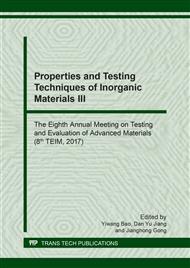[1]
El-Raghy T, Blau P, Barsoum MW. Effect of grain size on friction and wear behavior of Ti3SiC2. Wear. 2000;238:125-30.
DOI: 10.1016/s0043-1648(99)00348-8
Google Scholar
[2]
Zhou Y, Sun Z, Chen S, Zhang Y. In-situ hot pressing/solid-liquid reaction synthesis of dense titanium silicon carbide bulk ceramics. Material Research Innovations. 1998;2:142-6.
DOI: 10.1007/s100190050076
Google Scholar
[3]
Zhou Y, Sun Z. Micro-Scale Plastic Deformation of Polycrystalline Ti3SiC2 Under Room-Temperature Compression. Journal of the European Ceramic Society. 2001;21:1007-11.
DOI: 10.1016/s0955-2219(00)00310-1
Google Scholar
[4]
Finkel P, Barsoum MW, El-Raghy T. Low temperature dependence of the elastic properties of Ti3SiC2. Journal of Applied Physics. 1999;85:7123-6.
DOI: 10.1063/1.370521
Google Scholar
[5]
Barsoum MW, El-Raghy T, Rawn CJ, Porter WD, Wang H, Payzant EA, et al. Thermal properties of Ti3SiC2. Journal of Physics & Chemistry of Solids. 1999;60:429-39.
DOI: 10.1016/s0022-3697(98)00313-8
Google Scholar
[6]
Myhra S, Summers JWB, Kisi EH. Ti3SiC2-A layered ceramic exhibiting ultra-low friction. Materials Letters. 1999;39:6-11.
DOI: 10.1016/s0167-577x(98)00206-7
Google Scholar
[7]
Lis J, Miyamoto Y, Pampuch R, Tanihata K. Ti3SiC-based materials prepared by HIP-SHS techniques. Materials Letters. 1995;22:163-8.
DOI: 10.1016/0167-577x(94)00246-0
Google Scholar
[8]
Li JF, Sato F, Watanabe R. Synthesis of Ti3SiC2 polycrystals by hot-isostatic pressing of the elemental powders. Journal of Materials Science Letters. 1999;18:1595-7.
Google Scholar
[9]
Zhang ZF, Sun ZM, Hashimoto H, Abe T. A new synthesis reaction of Ti3SiC2 from Ti/TiSi2/TiC powder mixtures through pulse discharge sintering (PDS) technique. Material Research Innovations. 2002;5:185-9.
DOI: 10.1007/s10019-002-8644-4
Google Scholar
[10]
Zhang ZF, Sun ZM, Hashimoto H, Abe T. Fabrication and Microstructure Characterization of Ti3SiC2 Synthesized from Ti/Si/2TiC Powders Using the Pulse Discharge Sintering (PDS) Technique. Journal of the American Ceramic Society. 2003;86:431-6.
DOI: 10.1111/j.1151-2916.2003.tb03317.x
Google Scholar
[11]
Gao NF, Li JT, Zhang D, Miyamoto Y. Rapid synthesis of dense Ti3SiC2 by spark plasma sintering. Journal of the European Ceramic Society. 2002;22:2365-70.
DOI: 10.1016/s0955-2219(02)00021-3
Google Scholar
[12]
Palmquist JP, Jansson U, Seppanen T, Persson POA, Birch J, Hultman L, et al. Magnetron sputtered epitaxial single-phase Ti3SiC2 thin films. Applied Physics Letters. 2002;81:835-7.
DOI: 10.1063/1.1494865
Google Scholar
[13]
Goto T, Hirai T. Chemically vapor deposited Ti3SiC2. Materials Research Bulletin. 1987;22:1195-201.
DOI: 10.1016/0025-5408(87)90128-0
Google Scholar
[14]
Yang J, Dong S, Ding Y, Wang Z, Zhou H, Lu B. Fabrication of High‐Purity Ti3SiC2 Powders by an In Situ Reaction of Polycarbosilane and Metal Titanium. Journal of the American Ceramic Society. 2010;93:2117-20.
DOI: 10.1111/j.1551-2916.2010.03672.x
Google Scholar
[15]
Yang J, Zhang X, Wang Z, He P, Gao L, Dong S. Fabrication of Ti3SiC2 powders using TiH2 as the source of Ti. Ceramics International. 2012;38:3509-12.
DOI: 10.1016/j.ceramint.2011.12.037
Google Scholar
[16]
Li X, Westwood A, Brown A, Brydson R, Rand B. A convenient, general synthesis of carbide nanofibres via templated reactions on carbon nanotubes in molten salt media. Carbon. 2009;47:201-8.
DOI: 10.1016/j.carbon.2008.09.050
Google Scholar
[17]
Li X, Dong Z, Westwood A, Brown A, Zhang S, Brydson R, et al. Preparation of a titanium carbide coating on carbon fibre using a molten salt method. Carbon. 2008;46:305-9.
DOI: 10.1016/j.carbon.2007.11.020
Google Scholar
[18]
Guo X, Wang J, Yang S, Gao L, Qian B. Preparation of Ti3SiC2 powders by the molten salt method. Materials Letters. 2013;111:211-3.
DOI: 10.1016/j.matlet.2013.08.077
Google Scholar
[19]
You-Qi LI, Chang-Ming KE, Hou SX, Han BQ, Nan LI. Research on Reduction of Panzhihua Iron and Steel Co. BF Slag by Carbon Thermal Reaction. Bulletin of the Chinese Ceramic Society. 2007;26:447-0.
Google Scholar
[20]
Han B, Wang P, Ke C, Yan W, Wei Y, Li N. Hydration behavior of spinel containing high alumina cement from high titania blast furnace slag. Cement & Concrete Research. 2016;79:257-64.
DOI: 10.1016/j.cemconres.2015.09.019
Google Scholar
[21]
Zhang S, DDJ, Bhattacharya G, WEL. Molten Salt Synthesis of Magnesium Aluminate (MgAl2O4) Spinel Powder. Journal of the American Ceramic Society. 2006;89:1724–6.
DOI: 10.1111/j.1551-2916.2006.00932.x
Google Scholar
[22]
Jayaseelan DD, Zhang S, Hashimoto S, Lee WE. Template formation of magnesium aluminate (MgAl2O4) spinel microplatelets in molten salt. Journal of the European Ceramic Society. 2007;27:4745-9.
DOI: 10.1016/j.jeurceramsoc.2007.03.027
Google Scholar
[23]
Liu X, Zhang S. Low-Temperature Preparation of Titanium Carbide Coatings on Graphite Flakes from Molten Salts. Journal of the American Ceramic Society. 2008;91:667–70.
DOI: 10.1111/j.1551-2916.2007.02184.x
Google Scholar
[24]
Bao K, Wen Y, Khangkhamano M, Zhang S. Low‐temperature preparation of titanium diboride fine powder via magnesiothermic reduction in molten salt. Journal of Irrigation & Drainage. 2008;100:123-7.
DOI: 10.1111/jace.14649
Google Scholar


